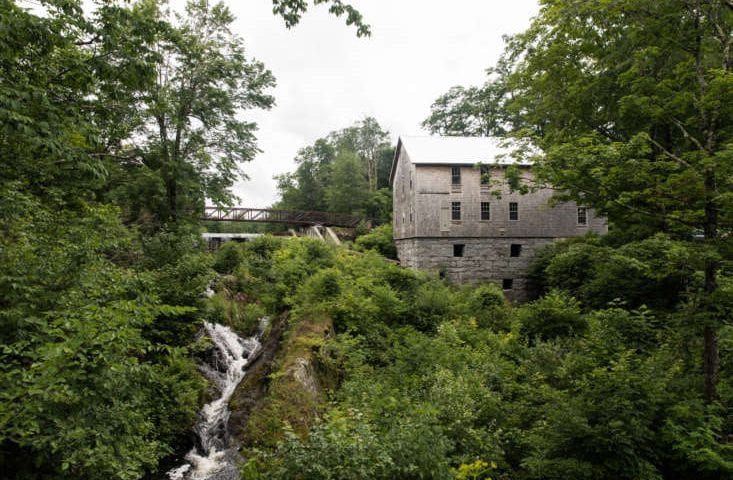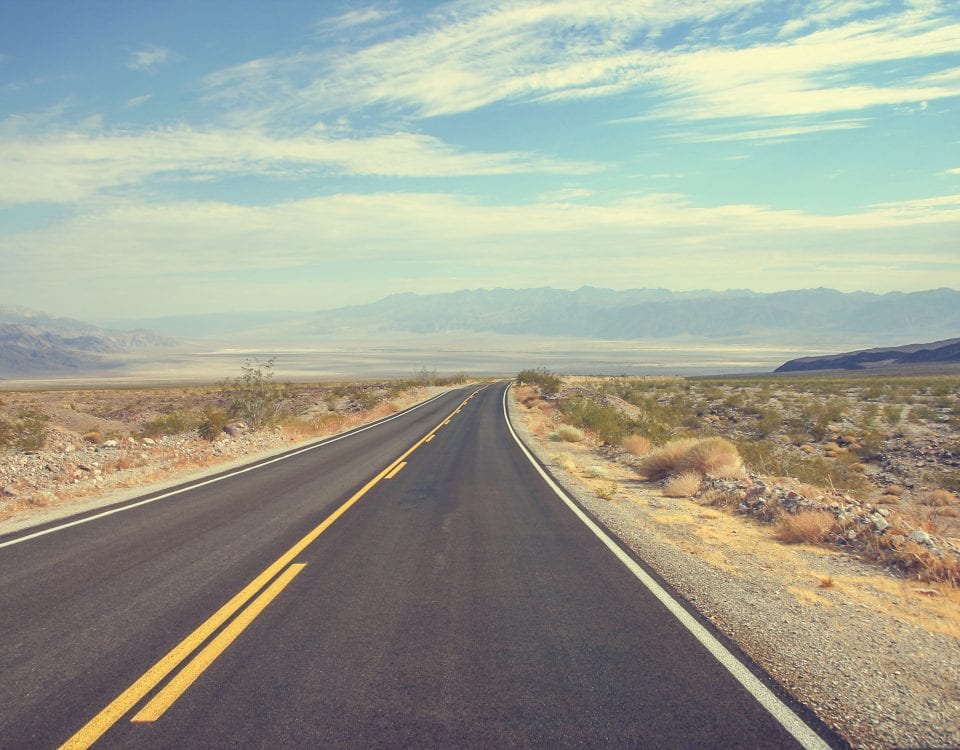
Day 31: By the Time We Got to Woodstock
April 19, 2021
Day 29: Coasting Along Through Maine
April 17, 2021Most recently updated on March 30, 2024
Partially driven on July 22, 2023 and July 24, 2023
Originally posted on April 18, 2021
It seems appropriate we will reach the halfway point of this journey after following in the footsteps of many a presidential candidate as well as taking a moment to honor some of our country’s astronauts.
The day begins, though, with a little backtracking through the state of Maine.
Out of Rockport, we take the two-lane Highway 105 in a northwesterly direction until we hit another narrow roadway, Highway 231.
After a half-hour, we zoom through Searsmont, a town of 1,400 people in the midst of rural southern Maine.

The community was formed at the junction of several Native American trails. The area was originally called Quantabacook.
The first European settlers arrived in 1770. David Sears, a business owner from Boston, founded the town with other pioneers in 1804.
The area was known for its fertile soil, water power and white pine forests. In 1886, the town had three lumber mills, four carriage factories, a pump factory, a tannery and a coffin factory.
There is still one saw mill in town, owned by Robbins Lumber. The company was founded in 1881 and employs about 115 people in four locations.
The town is trying to take a step in the more modern world. In September 2021, Searsmont began discussions with four other Waldo County communities about forming a municipal utility that would provide high-speed broadband internet service. Local officials say the COVID-19 pandemic demonstrated the need for quick, reliable internet service, even in small rural towns. In August 2022, the five communities formed the non-profit Broadband Utility District to provide high-speed internet. In December 2023, the utility received a grant to begin construction of the broadband system. The $15 million project is expected to be completed in 2026.
———————————————–
Highway 131 out of Searsmont takes you around Quantabacook Lake to Highway 137.
In less than a half-hour, you’ve reached Freedom, a village of about 700 people with no other towns within 15 miles. It’s one of the Waldo County communities partnering with Searsmont for broadband internet service.
The town was settled in 1794 by Revolutionary War soldier Stephen Smith and incorporated in 1813. The local farmers grew hay and potatoes. The town also had a flour mill, corn mill, shingle mill, saw mill and several factories.
Most of those are now gone, so the big attraction is The Lost Kitchen.
This farm-to-table restaurant is owned by chef Erin French, who grew up in the area.
More than a decade ago, French owned another restaurant called The Lost Kitchen in the town of Belfast, Maine. After two years, she lost the restaurant and her husband in a divorce.
Afterward, French rented an Airstream and served pop-up dinners. In 2014, she returned home and opened a new Lost Kitchen on the first floor of a refurbished mill near the waterfalls of Sandy Stream.
The restaurant, whose 15-person staff is almost all female, has only eight tables with a maximum seating capacity for 40 people. There’s only one menu per night and it’s different each evening. The lineup is selected that day, depending on what ingredients are available.

Chef Erin French preps at her restaurant, the Lost Kitchen, in Freedom, Maine. Photo by Greta Rybus for the Boston Globe.
The dinners cost $265 per person for the six to eight-course meals.
The Lost Kitchen is open four nights a week from May 1 to December 31. French and her staff start taking reservations in early April.
Word spread quickly about the restaurant.
In 2017, French and her crew received 10,000 phone calls for reservations on the first day in April.
In 2018, they had customers send in postcards postmarked between April 1 and April 10. They received 20,000 of them. The reservations were then picked randomly.
In 2019, they went the post card route again. Another 20,000 rolled in.
In 2020, they were all set for the onslaught of post cards again when the COVID-19 pandemic put the restaurant on hold for the year.
In 2021, the restaurants held some outdoor dining experiences during the summer before the dining room closed for the fall and winter.
For 2022, the restaurant began accepting postcards on April 1. The reservations were quickly filled. The tradition continued in 2023 and 2024.
French received some good news in summer 2020 when it was announced she would have a cooking show on the Magnolia Network, the new television enterprise owned by popular home restoration couple Chip and Joanna Gaines who were profiled on Day 8. The Lost Kitchen episodes are available on discovery+. The first 3 seasons are also available now on Amazon Prime.
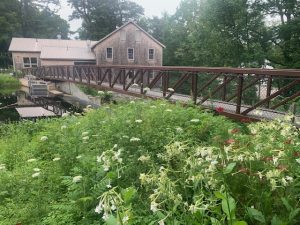
The Lost Kitchen restaurant in Freedom, Maine
French has also published a cookbook with recipes from her restaurant.
One person who can attest to The Lost Kitchen experience is Peter Ralston, the Rockport, Maine, resident we met during our Day 29 travels.
Ralston has dined at The Lost Kitchen. He told 60 Days USA that he and his dinner companions were quite impressed with the food as well as the atmosphere and setting.
“It was one of the most charming, beautiful evenings any of us have ever had,” he said.
We visited the rustic restaurant and gift shop in July 2023.
Getting to The Lost Kitchen is more of a pilgrimage than a destination. You need to drive close to an hour from the coast along a series of two-lane, wooded roads to get here.
Emily Johnson, a 6th grade science teacher from the Miami area, made the journey on this day, soaking in the place despite not being one of the lucky folks who snagged a dinner reservation.
Johnson told 60 Days USA that she has seen every episode of “The Lost Kitchen,” usually watching it with her mother, who works as a nurse. So, she made the drive up from southern Florida to absorb the place.
“I have lots of time off this summer, so why not take a road trip here? Maine has a special place in my heart,” she said.
Johnson planned to attend the farmer’s market on the site the following Tuesday in hopes of catching a glimpse of the famous chef.
“Erin French is my celebrity,” she said.
———————————————
From Freedom, it’s time to head southwest.
Highway 137 takes you to Highway 202, which in 40 minutes transports you to the state capital of Augusta.
Only 19,000 people live here, making Augusta only the 12th most populous city in Maine. It’s also the third least populous state capital in the country. It’s the smallest of the state capitals we will visit since Montpelier, Vermont, and Pierre, South Dakota, are not on our itinerary.
The Wabanaki tribe originally inhabited the area. English settlers from Plymouth Colony in Massachusetts established the town in 1628. However, raids by local tribe members forced settlers to vacate the region. They stayed away until the mid-1700s.
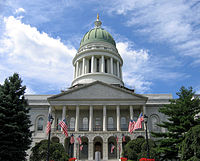
The state Capitol in Augusta, Maine. Photo by Wikipedia.
Fort Western was built in 1754 during the French Indian War. Benedict Arnold, when he was on our side, helped lead an unsuccessful attack on Quebec from the fort in 1755. Troops left the fort in 1767 and it became a trading post. The structure is still standing and is the country’s oldest surviving wooden fort.
Augusta was chosen as state capital in 1827 and chartered as a city in 1849.
The region’s rich soil helped boost the agricultural industry. The water power from local streams ignited the manufacturing industry.
By 1838, there were 10 saw mills in town. The railroad arrived in 1851 and in 1883 a cotton mill built of brick was established. In the late 1800s, a paper and pulp mill opened. Other plants produced lumber, doors, window shutters, broom handles, tools, shoes and furniture.
The completion of Interstate 95 in 1955 prompted businesses to leave the downtown area to move close to the freeway. There have been efforts since the 1980s to revitalize the city’s core.
The economy today focuses on state government and light industry.
The State House is the one of the main tourist attractions. It features a 185-foot-high dome. The building was completed in 1832 and made from Maine granite. Most of the original structure is now gone due to remodeling.
Politics and Outer Space
From Augusta, we head south on Interstate 95, revisiting the portion of yesterday’s route from Portland to Portsmouth.
It’s one of the few times on our journey we will retrace our steps.
The two-hour jaunt has put us back in New Hampshire, the second of seven states that we travel through twice.
The Granite State is one of our smallest. Its 9,349 square miles ranks it 46th in area.
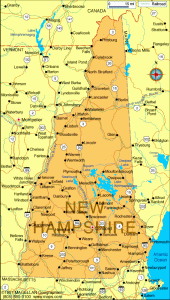
New Hampshire’s population of 1.4 million puts it in the 41st slot, slightly behind Hawaii but slightly ahead of Maine. About 89 percent of the residents here are listed as white. It also has the second highest median age at 43 years, behind only Maine.
The state’s highest point is Mount Washington at 6,288 feet. In 1934, the mountain recorded the strongest wind ever measured in the United States at 231 miles per hour.
Native tribes occupied the region for 12,000 years before the first European explorers arrived from England and France in the 1600s. The first official settlement was in 1623. In January 1776, New Hampshire became the first colony to establish a government independent of Great Britain, a move emblazed in the state’s motto of “Live Free or Die.”
In the 1800s, New Hampshire was a center for textiles, shoes and paper. Other factories, most of them located along rivers, lured French-Canadians across the border with the prospects of work.
The mills relocated to the South in the 1930s and 1940s. Defense contractors moved into many of the abandoned properties in the 1950s and 1960s. The state’s population increased in the 1980s as new highways that connected to Boston made southern New Hampshire a bedroom community.
Today, the manufacturing industry consists mostly of computer and electronic products. The main agricultural output is dairy products, followed by nursery stock, apples, maple syrup, sweet corn and potatoes.
Tourism is the state’s second largest industry. New Hampshire has some of the largest ski facilities on the East Coast. In the fall, tourists come to the region to observe the dramatic changing of the color of tree leaves.
New Hampshire has one of the lowest energy consumption levels in the country. In fact, one-third to one-half of the electricity produced here is sent to other states. Yet, New Hampshire has some of the highest electricity rates. The Seabrook Station Nuclear Power Plant near Portsmouth provides about 60 percent of the state’s electrical needs.
New Hampshire may be best known as the state that has held the first presidential primary. It’s been the initial primary state since 1920. The ballot used to contain the names of delegates. It was switched to the names of presidential candidates in 1948.
The state’s primary got its first national exposure in 1952 when President Harry Truman lost the Democratic contest to Estes Kefauver and dropped out the race.
New Hampshire law allows the secretary of state to schedule the primary date no matter what national party leaders say. That means that if another state moves it up its primary, then New Hampshire can make their date earlier to keep its slot as the first primary. However, in February 2023, Democratic party officials approved President Joe Biden’s plan to reshuffle the party’s primary calendar for 2024. Under this scenario, South Carolina was scheduled to hold the first primary on February 3 with Nevada and New Hampshire holding their elections three days later. However, in November 2023, state officials moved the New Hampshire primary up to January 23 in defiance of the Democrats’ plan. Biden won the Democratic primary despite not putting his name on the ballot because the election violated the new schedule.
New Hampshire law also allows any town with fewer than 100 people to open its polls at midnight and close them after everyone has voted. Dixville Notch, Hart’s Location and Millsfield are three communities that do so.
Presidential politics indeed will be a major theme as we motor through the southern portion of the state today.
————————————–
A few minutes after crossing the border, we grab Highway 101 and head west away from the shore.
About 45 minutes later, we enter Manchester, the most populous city in the state with 114,000 people. It’s also the largest city in the tri-state area of Vermont, Maine and New Hampshire.
The region was initially inhabited by the Namaoskeag tribe. They left the area before the 1720s. The first European settlers were Scottish-Irish. They arrived in 1722.
Known initially for its fishing industry, Manchester quickly developed into a mill town.
In 1805, a water-powered cotton spinning mill was established near a 55-foot drop on the Merrimack River. In 1807, a canal was built to connect the city with Boston.
In 1810, Amoskeag Cotton and Woolen Manufacturing began operating a cotton mill here. The facility expanded over the ensuing decades, at one point even building fire engines and trains. In 1848, the company’s Mill No. 11 was the largest cotton mill in the world with its 4,000 looms. The place was so loud that workers, many of them French Canadians, learned to read lips to communicate.
Other facilities in town produced cigars, shoes and paper. By World War One, there were 30 mills in town that employed 17,000 people.
The textile industry started to fade during the Great Depression and the Amoskeag facility went out of business in 1935. Part of that old factory has been converted into retail and office space. The other part is the Millyard Museum, which traces the history of the town and its factories.
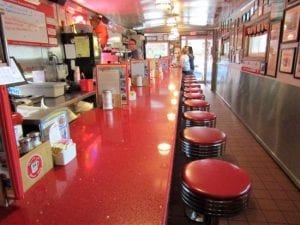
The Red Arrow Diner in Manchester, New Hampshire. Photo by TripAdvisor.
The economy today is driven by health, financial, communication and energy companies, although manufacturing plants still produce textiles, airplane parts, automobile parts and electronics.
Manchester also has some strong ties to presidential politics.
For starters, it’s the home of the New Hampshire Union Leader, a conservative publication that for a century endorsed Republican candidates. That 100-year streak was broken in 2020 when the paper endorsed Democratic nominee Joe Biden over President Donald Trump.
The paper gained national attention in February 1972 when two reports were printed that criticized Maine Senator Ed Muskie, then the front runner for the Democratic presidential nomination, and his wife. While outside the newspaper criticizing the pieces, Muskie appeared to start crying. Muskie won the New Hampshire primary a few days later, but his perceived breakdown eventually derailed his presidential campaign.
The city is also home to the Red Arrow Diner. The 100-year-old restaurant that is open 24 hours is a must-stop for presidential candidates when they visit the state. The walls feature photos from presidential hopefuls such as Al Gore, Hillary Clinton, Ben Carson, John Kasich, Ted Cruz and John Edwards. There’s also pictures of the successful candidates, including Donald Trump and Barack Obama.
The Manchester area also has some strong ties to the comedy world. Comedians Seth Meyers, Adam Sandler and Sarah Silverman all grew up in the region.
——————————–
We continue on the presidential political trail as we head north on Interstate 93.
Just 15 minutes up the freeway is Hooksett, a town of 14,000 residents.
The community was incorporated in 1822 and appears to have been named after a bend in the Merrimack River.
What brings us here today is a simple grocery store that stood on the banks of the river for nearly 200 years.
Robie’s Country Store was owned and operated by five generations of the Robie family from 1887 to 1997.
During that time, it became a traditional campaign stop for presidential candidates as they swung through New Hampshire.
After the Robie family departed, a group of local citizens formed to save the building and turn it into a living history museum.
The non-profit Robie’s Country Store Historic Preservation Corporation oversees operations with its all-volunteer staff. The building is now on the National Register of Historic Places. It’s also designated as a Save America’s Treasures project.
In August 2023, it was announced that the store will reopen under the management of a Robie family cousin. The building will still be owned by the historic preservation corporation.
———————————————-
It’s just another 15 minutes north on Interstate 93 to reach the final destination for today.
That would be the state capital of Concord, the second city by that name we’ve visited in the past three days and the 200th town on our journey.
Like Augusta, Concord is not a heavily populated capital. It only has 44,000 residents. That still makes it the third most populous town in New Hampshire.
This region was first inhabited by the Pennacook tribe. They fished for salmon and sturgeon as well as planted maize, beans and other crops.
Europeans first settled here in 1727 and incorporated their town in 1734. Some of the homes from that era can still be found on the north end of Main Street.
Concord was named state capital in 1808 and finished building its gold-domed Capitol in 1819. It’s the oldest state house in the country where the legislature still meets.
The canal system to Boston that opened in 1807 spurred the economy.
Early on, furniture manufacturing and granite quarries were the big industry. The granite from north of town was used not only in Concord’s Capitol building but also in the Library of Congress in Washington, D.C.
Publishing was also a major industry. Rumford Press was once the third largest printer in the country, employing 600 people. Its publications included Atlantic Monthly and Reader’s Digest.
The Abbot and Downing Company started manufacturing Concord stagecoaches in 1826. The wagon was the standard vehicle for Wells Fargo Bank. Abbot and Downing made 3,000 coaches between 1826 and 1900. Their facility occupied 6 acres and employed 275 people.
Concord also became a railroad hub when the line between Concord and Boston opened in 1842.
In the 1900s, Concord became more of a distribution center for dairy products and apples.
The economy today is focused on healthcare, insurance and state government.
Politics is deeply embedded into Concord’s history.

The McAuliffe-Shepard Discovery Center in Concord, New Hampshire. Photo from the Discovery Center.
Just north of downtown is Pierce Manse, the home of Franklin Pierce, the 14th president of the United States. Pierce, the only president to hail from New Hampshire, and his family lived in the house from 1842 to 1848. His gravesite in the Old North Cemetery in Concord also includes his wife and two of their children. There’s also a statue of Pierce in Concord that was erected in 1914.
The downtown region features a trio of politically historic sites.
For starters, there’s the state Capitol, which is one of the smaller state houses in the country. Nonetheless, the building contains the Hall of Flags, which features more than 100 battle flags.
Across the street is the Eagle Hotel, which was built in 1854. The hotel was a frequent meeting place for politicians who were in town. They included Presidents Ulysses S. Grant, Benjamin Harrison and Rutherford B. Hayes. Pierce spent the night here before traveling to Washington for his inauguration. The hotel closed in 1961 and it is now a historic building.
Just a couple blocks away is Phenix Hall, a 500-seat auditorium that has seen its share of political speeches, lectures, shows, wrestling matches and agricultural fairs. Abraham Lincoln spoke here in 1860. So did Theodore Roosevelt in 1912. The building today is only allowed to hold 99 people due to fire codes, but there are plans to return it to its former glory.
Concord also pays tribute to the nation’s astronauts.
One of them is Alan Shepard, the New Hampshire native who was the first American to travel into space in 1961. Shepard, a former test pilot, also walked on the moon in 1971 as part of the Apollo 14 crew.
The other is Christa McAuliffe, the Concord High School teacher who died along with six other astronauts in the 1986 Challenger space shuttle disaster.
McAuliffe was teaching at Concord High School when she was chosen from 11,000 applicants in 1985 to be the first participant in NASA’s Teacher in Space program.
Concord High School is still open, educating 1,500 students every year.
There’s also the Christa McAuliffe School, an elementary campus named after her in 2012.
In addition, there’s the McAuliffe-Shepard Discovery Center north of downtown. The complex features exhibits on astronomy, aviation and other sciences. It’s open Wednesdays through Sundays during spring, fall and winter as well as every day during the summer.
Katie Marinoff-Silk, the center’s director of development, told 60 Days USA in spring 2021 that the facility originally opened in the 1990s as the Christa McAuliffe Planetarium to honor her as well as to provide education services.
In 2009, it was expanded into the McAuliffe-Shephard Discovery Center. Marinoff-Silk said the goal is the same with the belief being that science is important to our society.

Inside the McAuliffe-Shepard Discovery Center in Concord, New Hampshire. Photo by The Concord Insider.
“The way I think about science is getting to know the world around us, to know our place in the universe,” she said.
The center has a strong school program since McAuliffe was a teacher.
“Education is part of our mission,” Marinoff-Silk said. “Access to education is important to offer kids at a young age. This gives them an opportunity to have fun while they’re learning.”
She said McAuliffe remains important to the center as well as the community at large because she was an astronaut who wasn’t a military veteran.
“Christa McAuliffe really represents the normal person’s connection to space,” said Marinoff-Silk. “She was someone who could be in everyone’s daily life.”
“I think it’s important to have a place where people can come and learn a little bit about her and the information she was trying to teach people,” she added.
Marinoff-Silk has lived in the Concord area since 2002.
She said most communities in New Hampshire have the same tight-knit, small town feel.
People tend to be outdoor enthusiasts. Marinoff-Silk is a big hiker, but unlike other New Hampshire residents who will ski or snowshoe during the cold winter months, she prefers to hunker down inside with a warm cup of tea.
She noted that the presidential primaries every four years is a huge deal in New Hampshire. Most people are into it, but it’s difficult to get away from it, even if you’re not interested.
Marinoff-Silk met presidential candidates Bernie Sanders and Hillary Clinton in 2016. She says you can meet a presidential candidate in New Hampshire during primary season if you so desire. It’s not hard to do.
With that, I vote that we stop here for today.
Tomorrow, it’s paint ball in New Hampshire and maple syrup in Vermont before we visit the state of New York again where we’ll check in on an apple orchard as well as a small town that is legendary in rock music history.

